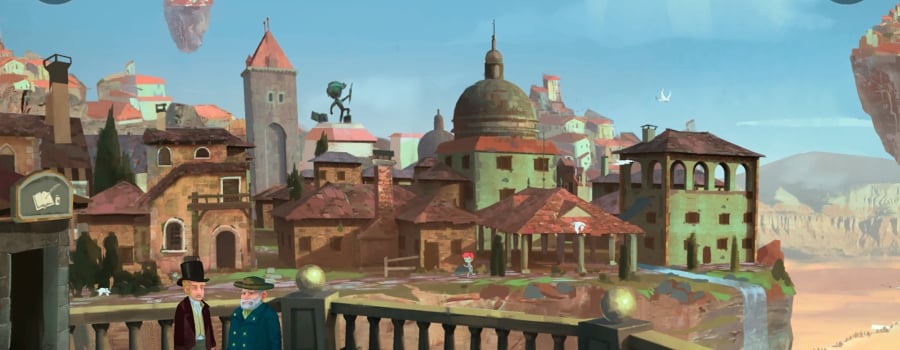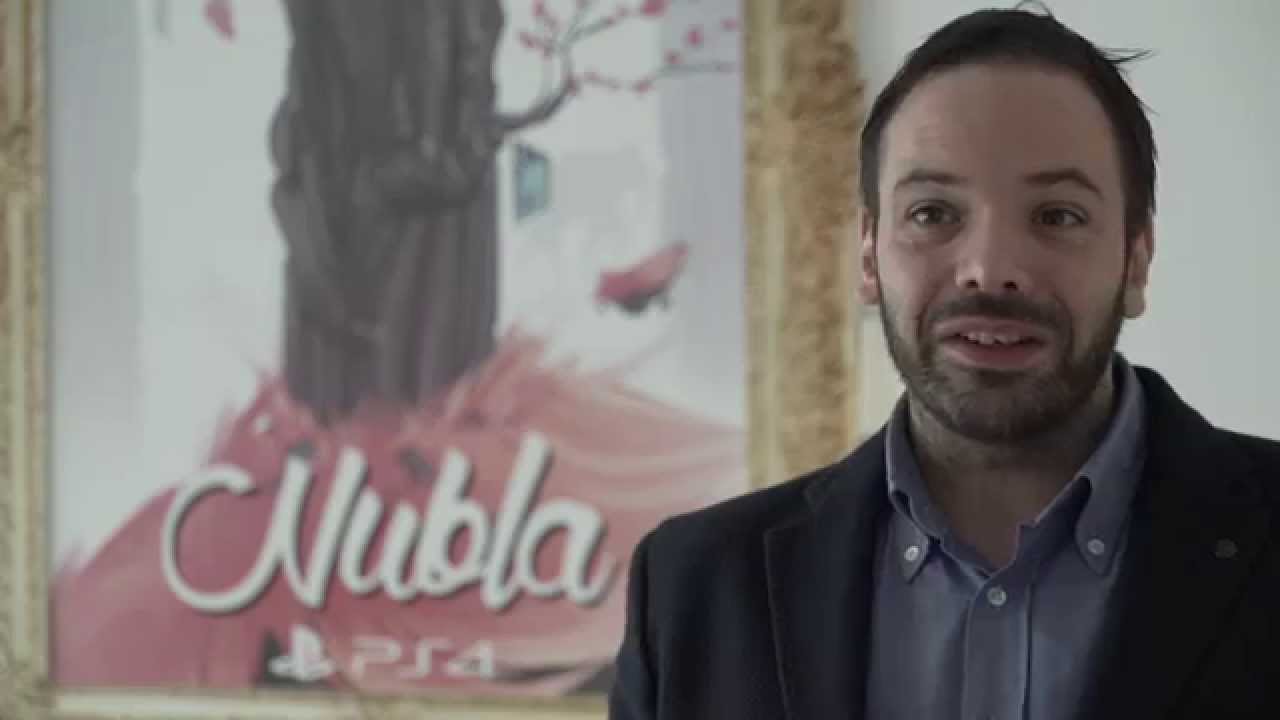
“We understand the video game as a place to discover, imagine, and invent other possible worlds and realities. We believe that with video games, we can generate social awareness and a critical digital citizenship.”
This message from Gammera Nest, developers of Nubla 2 (winner of the Best Game Design Award at GameDaily Connect USA in August), shows the importance of games as a means of touching their players in ways that will help them grow in empathy and thought. It also touches on their focus in exploring what games can do, with each game being something unique that only Gammera Nest’s team could do together.
In the Nubla games, the development studio has sought this kind of connection in the literal exploration of art, having players work through a platformer designed around artistic works from the Museum of Modern Art Thyssen-Bornemisza. This intriguing mixture of play and exploration, when combined with historical paintings and artistic visions, sought to bring an interactivity to the viewing that would bring the player deeper into the meanings of the works, as well as seek their own meanings within.

Such a task was daunting for the Madrid-based developer. “Every aspect of Nubla was a challenge. Let’s start by reminding ourselves that it all started in the National Museum Thyssen-Bornemisza, and it was formulated as a creative, as well as a technological, exercise: how could we make a story out of the paintings of the museum?” said Daniel Sanchez, CEO of Gammera Nest.
“From that starting point, a small indie studio such as Gammera Nest met with PlayStation Spain to develop a game with one of the biggest scopes ever seen in Spain. It took three years of development with a budget of around €500,000 and almost 50 people involved in its development. For a team barely experienced in mobile development and prototyping, managing all this and making a successful game was a challenge indeed!” he continued.
It was also challenging purely as a developer from Madrid. “You have to take into account that we come from Spain. Although its market is the fourth biggest in Europe, its industry has to learn a lot about professionalization and, above all, how to get their projects funded and how to approach the media. You can only learn about these essential things by taking part in events like this one [GameDaily Connect USA], which help to put cultural, risky projects like Nubla 2 under the spotlight.”
It may have been a challenging prospect for the studio, but it was a deeply compelling prospect for them as well. As they sought different ways to explore the artworks and have the players ruminate on them, their own development strategies and techniques evolved, always growing over multiple Nubla titles and through the unique visions brought in through the various people they had working on each project.
“Nubla 2 development started as soon as we shipped the first game. Nubla was released in November 2015 in Europe, the next Summer, around June, we organized a workshop where we started The Islands of Nubla (available on iOS and Android), and there we found what would be the core team of the second game. They were an art team formed by Gabriel Jiménez and Erika Romero, Clara Harguindey as game designer, and Miguel Valladares composing the music. Antonio García, Manuel Martínez, and Eduardo Cueto joined the team – they had been doing another project with us and the Archeological Museum of Madrid,” said Sanchez.
Not only did these new artists, composers, and coders bring their talents, they also brought their own ideas and topics for the next game to explore. “This core team started discussing how the second game should be. We started with what we had learned from Nubla, but could not implement back then. If the first Nubla was focused on the observation – even direct copying – of the paintings, Nubla 2 would be an artistic reinterpretation in search of some themes which cross every artistic period: the role of women in art, the controlling society, the refugees… Topics we weren’t looking for, but that surfaced as we were inviting people to the project and walking through the Museum once and again,” he continued.
Part of this growth came in seeing the artists’ connections to their works, and how the people who created them were also a key part of the story and connection Gammera Nest sought. “Probably the most important single moment was when we realized we needed the authors. The landscapes of Nubla were directly inspired by the paintings, and we even included some of their characters, but we realized that Nubla 2 required us to present the painters as part of the story,” said Sanchez.
It meant a great deal of work and thought for the studio, but for Sanchez and the team at Gammera Nest, it would be impossible to do otherwise. Their passion for the work would be what made it stand out and have a chance in this challenging market in games.
Sanchez speaks to this when asked what advice he has for other indies. “Find your voice. Everyone can make a video game – you should make a game that only you could have made. Make me feel, and find a way to express yourself through your game. From triple-A games, people expect fireworks and a big show. But from us, they are expecting passion,” he said.
“The indie scene is and always will be difficult. It’s not exactly easy to compete against the big companies for visibility when they can fill every single promotional space. Finding a way to reach out to people and let them know about our games is always the greatest challenge. Thankfully, there’s something we indies are great at: we are quicker on our feet and we always find a way to squeeze through the small gaps these giants leave. There is always some big game that makes people want a bit more of that, but a bit differently. These niches will never disappear, and those smart and fast enough (you need both!) will make it,” he continued.
That passion and flexibility led to the developer’s exploration of art, which in turn led to their Indie Prize Award at GameDaily Connect USA. It was a stirring moment for the developer, signaling to them that their passion had paid off.
“This is one of the single most important accolades we have received in our history. It may not be a long story (our studio was born in 2013), but when we started working on Nubla, we never thought it would receive such an honor,” Sanchez said.
How do they intend to follow that heart and creativity next? “Right now, we’re working on four projects at the same time,” Sanchez noted. “Two of them may sound really far from the artistic nature of Nubla. One is the fantasy sport game Aces of the Multiverse, the other is Malnazidos, a third-person shooter based on a zombie movie.”
These might sound far from explorations of art, but Gammera Nest is still showing their own creative touches with each work. “We’ve added our ‘touch’ to both of them: Aces owes a lot to ‘70s and ‘80s sci-fi, and you can see that in its art style, its stories, etc. Not to mention the innovative mechanic of it being tied to a smartwatch counting your steps and transforming your exercise into in-game collectible cards. The AR direction of Malnazidos, on the other hand, is heavily inspired by comic books,” said Sanchez.
“With the profits from Nubla, we produced Nacho Rodriguez’s first work, The Many Pieces of Mr. Coo, an animated fantasy that turned us upside down (in a good way!). Besides, we’re working on a therapeutical VR project for ADD patients,” he continues.
“After Nubla, we needed to expand our study and scope – but without leaving our goals and personality behind. Lots of these projects will be done by 2020 Q1 and Q2, and currently we are looking for funds and co-production opportunities in the US for our next two projects, once again touching topics such as interactive storytelling, adventure, and ecologism.”
For Sanchez and Gammera Nest, finding your own way to tell your stories, and putting the passions of your creators into your works, is the best way you can hope to stand out in a market filled with incredible games. By leaving your unique mark on games, players will be able to see and feel why your works are special, connecting with them as you both grow together.
GameDaily Connect Asia 2019 in Shenzen, China (November 10-12) will host the next Indie Prize showcase with plenty of talented developers exhibiting. You can register right here, and you should take advantage of the last minute discounts on tickets, as prices will be going up after October 11.
 GameDaily.biz © 2025 | All Rights Reserved.
GameDaily.biz © 2025 | All Rights Reserved.